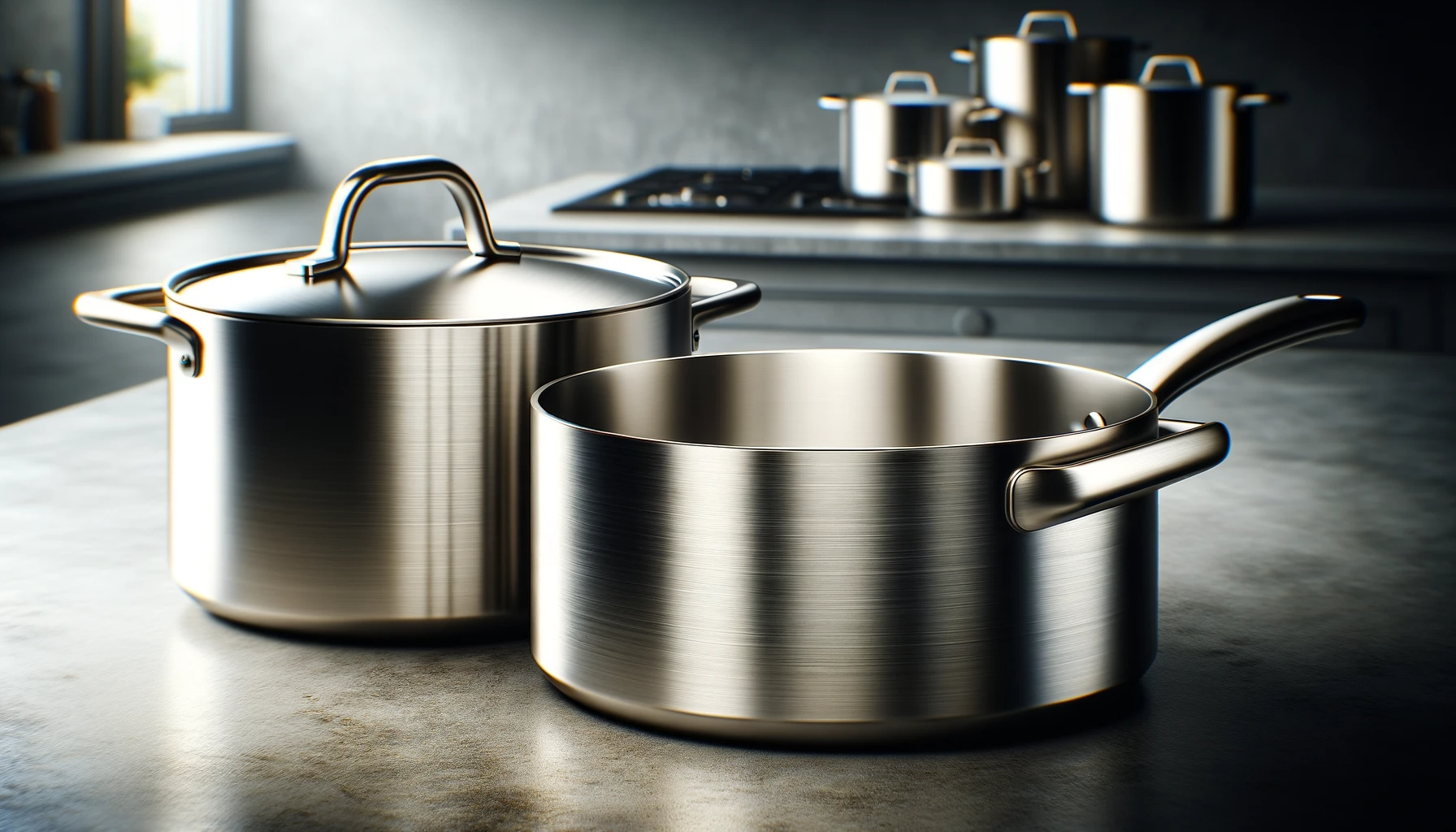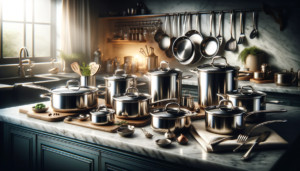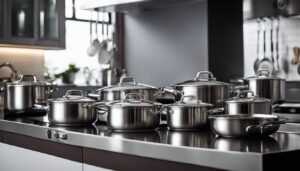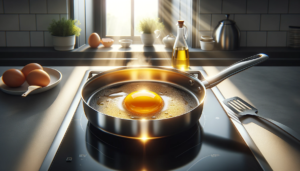With endless stainless steel cookware options today, one key decision is: brushed or polished finish? This surface texture choice impacts aesthetics and ease of care.
Brushed and polished stainless steel cookware differ in durability, ease of cleaning, visual appeal and price.
But their cooking performance is similar.
Let’s dive in to understand the nuances between these two popular finishes to make the best choice for your needs
Brushed vs Polished Stainless Steel Cookware

When choosing between brushed versus polished stainless steel cookware, brushed is typically the more durable and budget-friendly option while polished offers a brighter, showroom shine when cared for properly.
Both perform similarly when cooking.
Brushed stainless steel hides scratches better thanks to its textured finish.
It also costs 20% less than polished on average.
However, polished stainless steel looks more elegant and requires diligent cleaning to maintain its flawless mirror-like surface.
Below we’ll explore the nuances further to determine what’s best for your needs.
What is Brushed Stainless Steel Cookware?
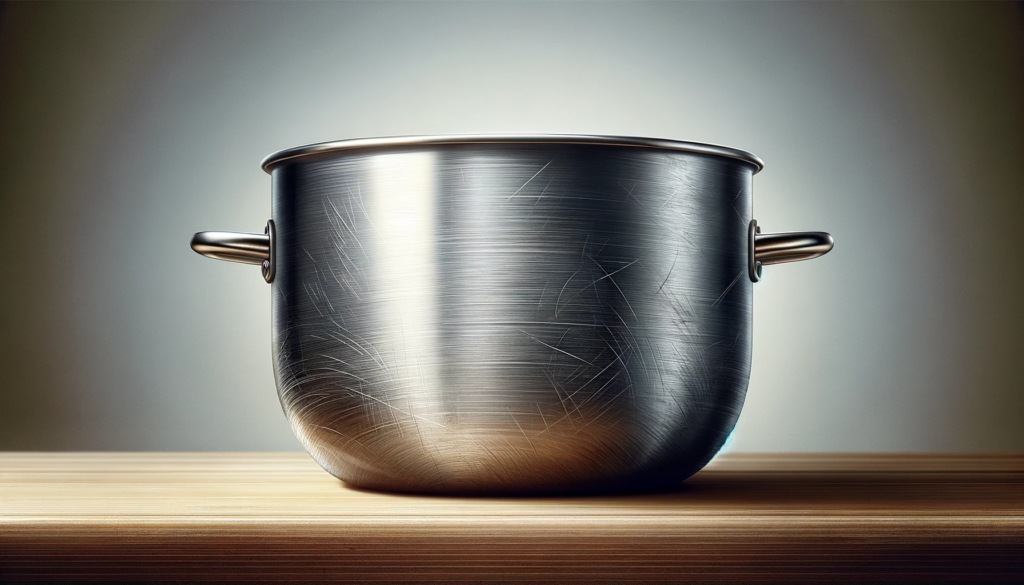
Brushed stainless steel cookware refers to pots and pans that have a dull, non-reflective finish.
The brushing process that these pots and pans go through gives the stainless steel a textured look and feel rather than a shiny, mirror-like finish.
This finish is achieved by abrasive brushing of the surface of the cookware, which serves to disrupt and scratch the steel.
The resulting brushed finish has a matte appearance that hides minor scratches and other small imperfections in the surface better than polished cookware.
Brushed stainless steel maintains a more uniform look over time compared to polished cookware.
Durability Differences

Brushed stainless steel’s textured finish makes it less prone to visible scratches and scuffs from regular kitchen use over time.
Minor surface abrasions blend into the brushed pattern more seamlessly compared to polished steel.
As such, brushed stainless steel keeps its newer look longer, hiding signs of wear and tear that would otherwise be readily visible on polished steel surfaces.
The abrasions in brushed steel that come from contact with cooking utensils are masked by the original brushed pattern applied through machine brushing during production.
Light scratching doesn’t stand out against this subtly textured backdrop.
In contrast, polished stainless steel shows wear more easily in the form of surface scratches and scuffs.
Its smooth, mirror-like finish has no texture to hide abrasions.
Scratches immediately disrupt and reflect light differently than the uniform polished surface, making them clearly visible.
Over time, continual surface scratching from regular use deteriorates polished steel’s original flawless shine.
Unless re-polished professionally, these gradual signs of wear remain visible.
So those wishing to maintain a pristine, scratch-free look over many years of use are generally better served by brushed stainless steel cookware.
Ease of Cleaning

The textured brushed finish makes stainless steel pots and pans easier to clean when cooking sticky or crusty foods.
The nooks and crannies inherent in the brushed steel surface can catch pieces of food, but also hide it visually.
As such, having bits of residue blend into the brushed pattern is less of an eyesore compared to polished steel, where any stuck-on residue clearly contrasts against an otherwise smooth mirrored backdrop.
The textured surface also makes brushed stainless steel less prone to obvious fingerprint smudging during cooking and cleaning.
Polished stainless steel requires more frequent and thorough cleaning to maintain its bright, shiny, like-new appearance over time.
Without a textured surface to hide it, any cooking residue that sticks and crusts on the interior surface is clearly visible and can be difficult to remove if left too long.
Finger smudges also readily show on the ultra-smooth surface.
Maintaining the flawless, light-reflective properties of polished steel requires promptly and thoroughly cleaning after each use, as well as occasional re-polishing with specialty metal polish or chrome cleaner to revive the original high shine.
Visual Appeal
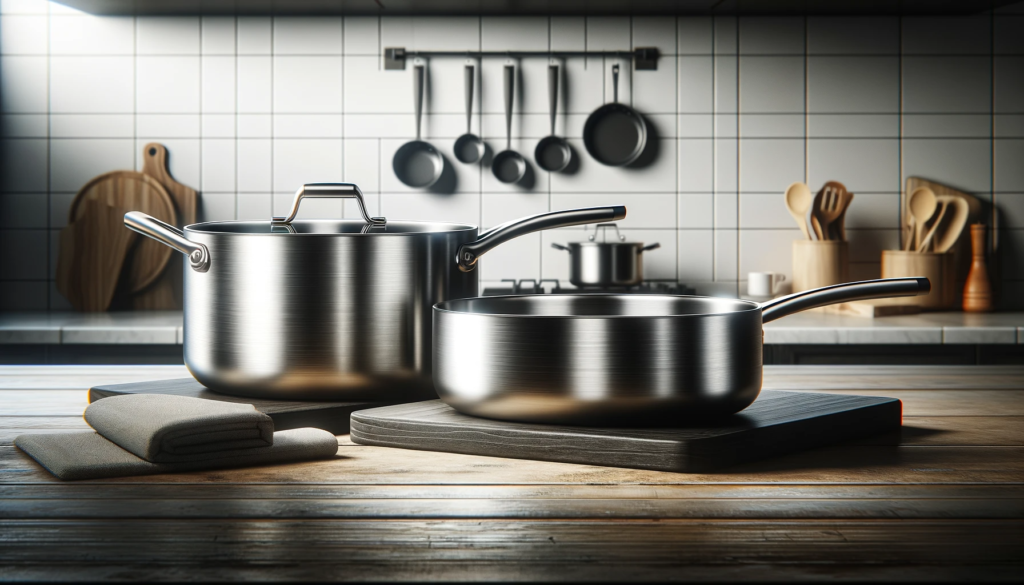
The visual appeal of brushed versus polished stainless steel cookware ultimately comes down to personal preferences for kitchen aesthetics and style.
Brushed stainless steel has an industrial, utilitarian look that fits well with contemporary kitchen decors emphasizing clean lines and understated materials.
Unlike polished steel, the brushed finish helps mask signs of wear-and-tear from years of cooking use, preserving a uniform visual texture.
So those favoring a lived-in aesthetic may prefer brushed over polished stainless steel.
Polished stainless steel looks much more elegant, refined and “new” out of the box.
Its mirror-like surface gives any kitchen a bright, clinically clean appearance.
The high shine finish resembles chrome, pairing ultra-modern style with professional restaurant kitchen aesthetics.
Polished cookware maintains this flawless, gleaming appearance longer if meticulously cared for.
So those prioritizing a pristine, opulent look favor polished stainless over functional-looking brushed variants.
Price Differences
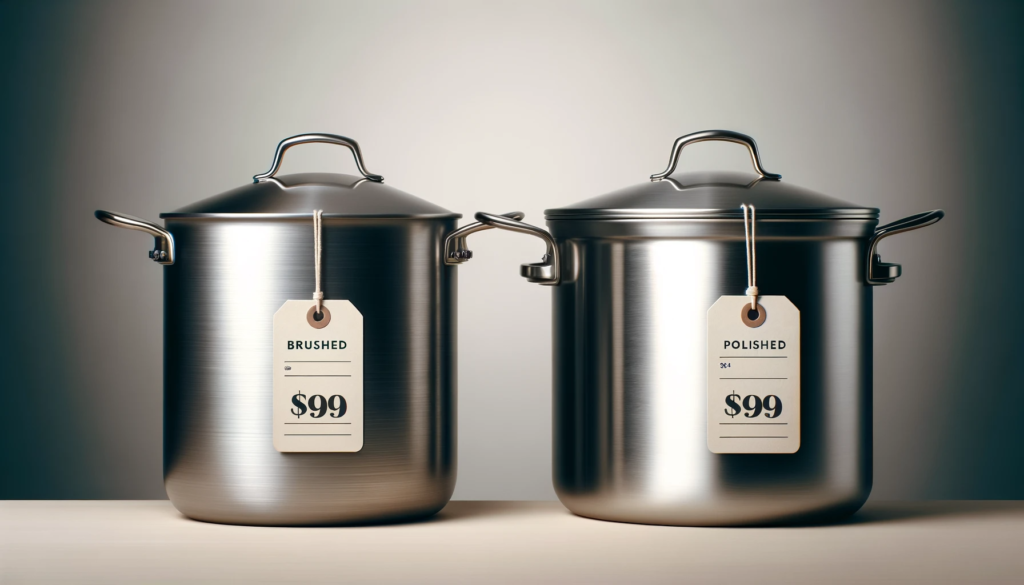
Brushed stainless steel pots and pans generally have a more affordable price point compared to polished stainless steel cookware.
The machine-brushing process adds relatively little to the production cost versus polished steel, which requires extensive buffing and progressive sanding with finer and finer grit compounds to achieve its flawless smoothness.
This labor-intensive finishing process meaningfully increases the costs of polished stainless steel cookware.
So on a feature-for-feature and capacity basis, brushed stainless steel pots and pans usually retail for at least 20% less than equivalent polished stainless steel cookware items.
Those on a tight cookware budget are better served by brushed stainless lines.
Heat Conduction Ability
Both brushed and polished stainless steel cookware perform very similarly when it comes to heat conduction and retention while cooking.
The stainless steel alloy composition is by far the dominant factor governing thermal properties.
Surface texture and finish have negligible impact on how efficiently pans conduct heat or how evenly they distribute it while cooking or baking.
Cooks will notice little functional difference between brushed and polished types in searing, frying, boiling water or any other cooking application.
This similarity in heating properties is unsurprising given how shallow the brushed texture and polished smoothness is relative to the pan’s overall thickness at over 2 millimeters.
Choosing What’s Right for You
Ultimately the ideal stainless steel cookware finish comes down to personal cooking habits, kitchen aesthetic preferences, and budget considerations unique to each home cook.
Visual appeal seems the most common deciding factory, as performance is similar between brushed and polished stainless pans.
Those wanting a brighter, ultra-modern personality favor polished steel’s clean look, while fans of an industrial style tend towards brushed stainless’ muted sheen.
Easy maintenance also appeals to busy cooks, with brushed steel hiding messes better.
For shoppers on a budget though, brushed stainless steel’s cost savings help tip decisions.
Carefully weigh these factors before investing in quality stainless steel pots and pans.
The finish you choose should match the existing personality and style of your kitchen decor.
For a seamless look, match cookware finish to the visual language set by the sink, faucet, appliances and color scheme.
Consider which finish hide wear best too.
Busy families prone to scrub abrasion may prefer brushed stainless, while those good at prompt gentle cleaning will get longer pristine life from polished pieces.
Brushed and polished stainless can both serve wonderfully given though to your family’s unique cooking lifestyle.
Conclusion
In closing, brushed and polished stainless steel both have merits depending on personal needs and tastes.
Brushed hides wear better over time while polished provides a brighter, flawless look when well-maintained.
Consider how you cook and clean when choosing between these handsome finishes to find the best fit.
Your cookware should match your kitchen decor and style.
